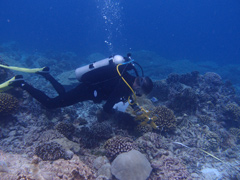February 2012 Expedition - Day 10 - Last day at Peros Banhos
This was our last day at Peros Banhos before we move onto the islands of the Great Chagos Bank.
A typical day, divers set off in the morning at 8am. Two teams went to the seaward reefs, a trip of about forty minutes in choppy seas, to continue various fish behaviour studies in undisturbed locations, and shark abundance counts.while others collected more lumps of old, dead coral colonies to extend their studies on the cryptic communities which, until now, have been an under-researched area of work. It is a point not usually appreciated, but the high diversity of small animals hidden or burrowing in the fabric of the reef is all-important, to biodiversity, reef productivity and food chains and to natural erosion and consolidation of the reef itself. The other dive team went to a knoll in the lagoon to recover the data logger that has been recording the water temperature at two hourly intervals since being placed two years ago; this extends for another two years this series of temperature recordings which started in early 2006. It is very satisfying when the marking stake is spotted and the LED light on the little instrument is seen to be still flashing, showing that its battery is still functioning and it clearly has not been damaged or filled with water! At the same time the island party surveyed the rest of the islands to continue the bird and vegetation mapping. And, as every day, the Pacific Marlin’s RIB took the BRUV team (fairly obviously we call them the bruvers) out to place and recover more of their underwater photography units.

In the afternoon two dive parties again went to the seaward reefs to a slightly different site, to continue work that they were doing in the morning with the fish work this afternoon being parrotfish sex change studies and hawkfish habitat use studies. The lagoon dive team returned to the site where the temperature logger was replaced to drill three short coral cores for palaeoclimatic research. By analysing the cores, past years’ temperatures can be deduced, and these will be compared with the temperature data actually recorded by the instrument to aid with calibration. Also, we collected tissue samples for DNA research into Indo-Pacific connectivity, and the samples will be sent to collaborating colleagues in different countries who have requested them. The bruvers continued to place their units. To date they have made over one hundred ‘drops’, producing about two hundred and twenty hours of video footage down to forty five metres deep. In Peros Banhos lagoon they saw beautiful coral gardens at forty metres deep and huge one and a half metre long grouper.
At the end of a dive, divers usually to do a three minute safety stop at five metres depth, often while hanging on to the anchor line. Entertainment during this compulsory ‘hanging around’ can consist of watching the other divers, watching the fish, hopefully not watching the sharks, but this afternoon for one dive team it consisted of watching a grouper and a moray eel fighting for the attentions of a cleaner wrasse. These little fish clean the larger fish of various parasites, much like the oxpecker bird does for rhinos in the savannah. We had always believed the rather nice idea that the various fish called a truce at the cleaning station and queued for the cleaner wrasse’s attentions. But not these two, the two metre long moray came out from under a coral table and the cleaner wrasse started to clean it’s teeth, but it was closely followed by the large grouper, which parked itself slightly in front of the moray’s nose and, by ‘quivering’, attracted the attention of the cleaner wrasse which started to clean the grouper’s scales. The moray then did a dash around to the front and got the attention of the cleaner wrasse again. They both leapfrogged each other several times when the moray disappeared under a coral leaving the grouper victorious.

Late afternoon the intrepid land party landed on Gunner’s Coin, a very small rocky islet out on the rim of the atoll. There is no sandy beach for an easy landing here, the waves constantly crash onto the rocky shore so getting ashore involves letting yourself be thrown onto the rocks and clinging on for dear life as the surge pulls back, and then quickly scampering out of the way of the next wave. Not for the feint hearted. They counted four nests of Masked Boobies, these are the least common of the boobies which occur in Chagos and only nest here and a similar rocky islet on the Great Chagos Bank. The nesting numbers of these birds vary from month to month and year to year, showing just how little we know about their breeding behaviour. There were also seventy recently used Wedge-tailed Shearwater nests. This rocky islet looks un unlikely place for any breeding bird but it is a necessary habitat for some species.

